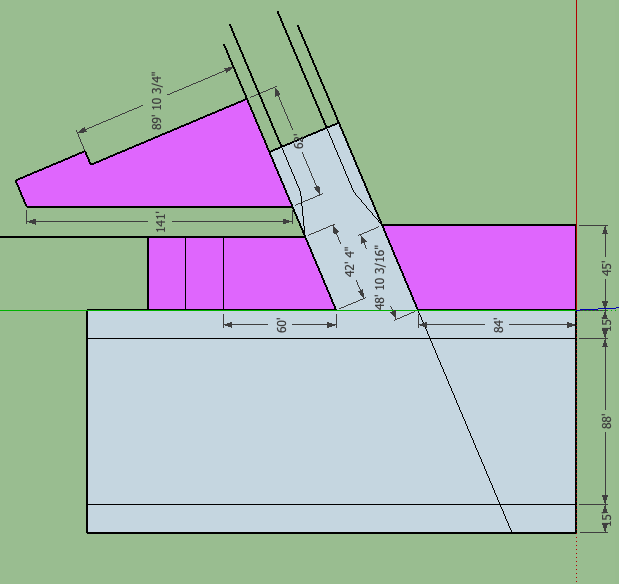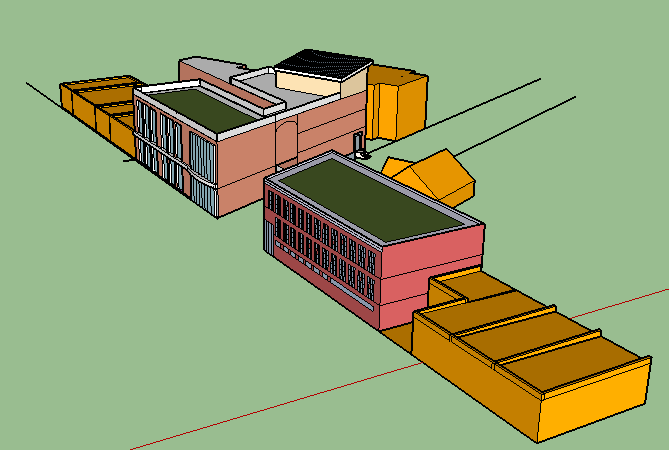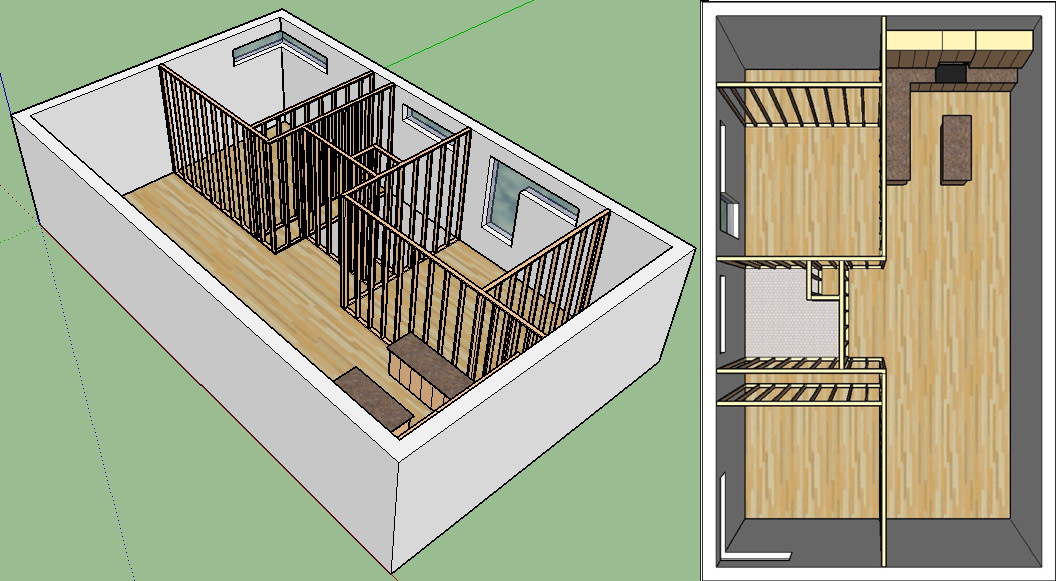Detroit Park City
Detroit Park City: Unlearning The Motor City’s Parking Culture is an ongoing design study focusing on parking and land use in the city of Detroit by proposing infill projects for specific sites. The study looks at existing parking lots, street grids, and buildings, and seeks to develop a better model to understand land valuation and density.
The study’s objectives are twofold.
At a design level, the objective of the study is to bring attention to the extraordinary amount of space in Detroit dedicated to parking, and to illustrate the high opportunity cost that comes with dedicating so much space to a use far less productive than revenue-generating, dense real estate. Part of this objective is to suggest alternatives to the paradigm of automotive transport in a city still heavily reliant upon it, even when that paradigm has failed the city macroeconomically (disinvestment and loss of jobs from the volatility and transitions of a monolithic industrial sector), microeconomically (businesses and families heavily dependent upon very expensive cars), and environmentally (Detroit has truly horrific air pollution, in no small part from car traffic, and runoff from traffic surfaces is a major source of water pollution and soil contamination).
At a practical level, the objective is to produce a model for the efficiency frontier of density. In Detroit, where the population density has a hard time breaking 5,000 people per square mile (less than 11600 people per square kilometer) we face a lack of nice things that would be afforded by more density. This includes basic commercial amenities like shops or restaurants. More abstractly, density means tax revenue means a better-developed built environment. Can we build dense enough to make underground parking financially feasible? Or do we get to a point where we instead say that enough is enough and a parking space isn’t worth $36,000, and we’d perhaps rather spend that money on public amenities?
While I’m trying to avoid getting bogged down in a granular level of detail in architectural design, I wanted to apply some specific design tenets. These include increasing overall lot permeability (thinking about long-term sustainability and urban resiliency at large, reducing stormwater runoff that would be otherwise caused by hardscaped parking surfaces and will not only flood basements but also cost money with the GLWA/DWSD’s new drainage charge) while also building as densely as realistically possible. Entries will usually explore cost options to build underground or above-ground parking. Many entries will attempt to match surrounding neighborhood density, if applicable.
Questions being asked when looking at a site: What used to be here? What did the neighborhood used to look like– “before the dark times, before the Empire” (where “dark times” may literally quite refer to the low-albedo asphalt as well as the hegemony of the parking space)? What does the neighborhood look like now? How can we address local market needs and some vague attempt at architectural continuity while also maximizing density?
STANDARDS OF PARKING
The first Detroit Park City post includes cost ranges to build surface, above-ground, and below-ground parking. Economies of scale help enormously for surface lots, but land value is difficult to factor in. This becomes a bigger problem when considering taxation, and quite monstrous indeed when thinking about how to equitably tax formerly improved land whose buildings have been demolished to build surface parking. The general rule of thumb is that surface parking in Michigan, as in many other jurisdictions, is effectively grossly undertaxed. This disincentivizes dense development but it also discourages the development of parking structures.
Another oft-examined standard is that of the size of a parking space. A parking space itself usually occupies 162 square feet. But because of inefficiency in design and the allowances required for getting in and out of a parking space, only about 49% of every parking lot is occupied by the parking spaces themselves. This number drops precipitously in parking garages, and more so in underground garages because of things like structural supports and ventilation.
STANDARDS OF HOUSING
In order to ensure uniformity, I first defined a “normal” apartment that would serve as a model for development alternatives to parking. The average apartment size has been shrinking in recent years, attributable to urban densification after the 2008 housing crash. People want smaller spaces and developers can squeeze more units into less space, guiding the market at large. In ten years, studios took the biggest hit with an 18% decrease to a cozy 504 square feet (rapidly approaching “micro” apartment territory). The average two-bedroom is a comfortable 934 square feet. Meanwhile, in single-family-land, the average home size has increased from about 1,500 square feet in 1975 to over 2,500 in 2013. 2,500 is palatial in comparison to a small apartment, but sky-high demand in urban cores plus the increasingly untenable costs of sprawl suggest that there’s not infinite demand for McMansionous living in the strip mall ‘burbs.
The below “model” unit is averaged based on these shrinking trends. It includes 872 square feet of living space and three closets, plus one for mechanicals. I’m going to use this as an average based on the above data given that some apartments will be smaller and some will be larger. Envelope design is important for especially smaller buildings, because, as I pointed out in a failed, though instructive, exercise to try and figure out some ways to optimize density, maximizing floor area while minimizing exterior building envelope. In lay terms, it’s inefficient to build low density because so much of a single-family building includes the exterior of the walls and the roof, which are extremely expensive to build, expensive to maintain, and represent massive energy losses.
Cost was difficult to estimate. A range of $130-180 for multi-family new construction is too large of a range. The mass exodus of construction professionals following the doldrums of the construction market from 2007-2011 generated a super tight labor market, driving up costs. Thinking about higher-end performance construction, Maine-based GOLogic, a manufacturer of prefab Passive House components, can get its per square foot price down to $227 . The original pilot GOHome actually cost under $150 per square foot!
Commercial soft costs may run 6-12% as a general rule of thumb. But as a well-trained budget hawk who has spent his career trying to make math work in Rust Belt cities where math doesn’t work, I’ve noticed that there is a Grand Canyon of disparity between dollars spent on 2×4’s and nails and profit going here or there: Factoring in a 40% net to the environmental engineers, a 40% margin to the HVAC contractor, a 15% net to the GC, etc., you can easily see how a $125,000 budget realistically comprises, say, 30-40% soft costs. This decreases in commercial construction, which is as much a case as as any to build denser, but that 6-12% is misleadingly small, because it excludes the margins within margins (marginception?!) of contractors and subcontractors. The maxim of “everyone has to make money [in order for things to get done]!” is at odds with the idea that everyone deserves a place to live.
Careful management alongside integrative, stringent design can mitigate some of this bloat. So, I’ve settled on total costs of $165 a foot, which accounts for reduction of some soft costs but also doesn’t put us at the lowest end of the range, and accounts for actually following building code, which, frankly, most contractors in Michigan do not.
THE SITES
The study, which originally aimed to produce one entry per week before I scaled that goal back because the city’s data files sometimes mysteriously disappear for weeks at a time and also #life, has examined the following sites (intersections or more precise location in parentheses).
No. 1: Mexican Village (Bagley Ave. & 18th St., Corktown, Detroit), July 2017
No. 2: Downtown Detroit (Larned & Shelby St.), August 2017
No. 3: Morounville, Detroit’s Riverfront (Jefferson & Grand Blvd.), November 2019
No. 4: Corktown (Michigan & Wabash), December 2019
No. 5: Main Post Office & West Fort Street, (Fort & Cabacier), December 2019
No. 6: Eastern Parket District, January 2020
No. 7: Lafayette & Cass, Downtown Detroit, date TBD
These will be posted in the blog and then will be linked here. Additional sites will be added over time. It should be noted that this is purely an academic design exercise and neither the author(s) nor Handbuilt City are working on behalf of any for-profit, public, or nonprofit entity in the production of this project.
FURTHER READING:
Chrest, Anthony, et al. Parking Structures: Planning, Design, Construction, Maintenance, and Repair. 2001.
Long, Charles. Finance for Real Estate Development. Washington: Urban Land Institute, 2011.
Schmitt, Angie. Right of Way: Race, Class, and the Silent Epidemic of Pedestrian Deaths in America. Washington, D.C.: Island Press, 2020.
Shoup, Donald. The High Cost of Free Parking. APA Planners Press, 2005.
Speck, Jeff. Walkable City: How Downtown Can Save America, One Step at a Time. North Point Press, 2012.
Suchman, Diane R. and Margaret B. Sowell. Developing Infill Housing in Inner-City Neighborhoods: Opportunities & Strategies. Washington: Urban Land Institute, 1997.



